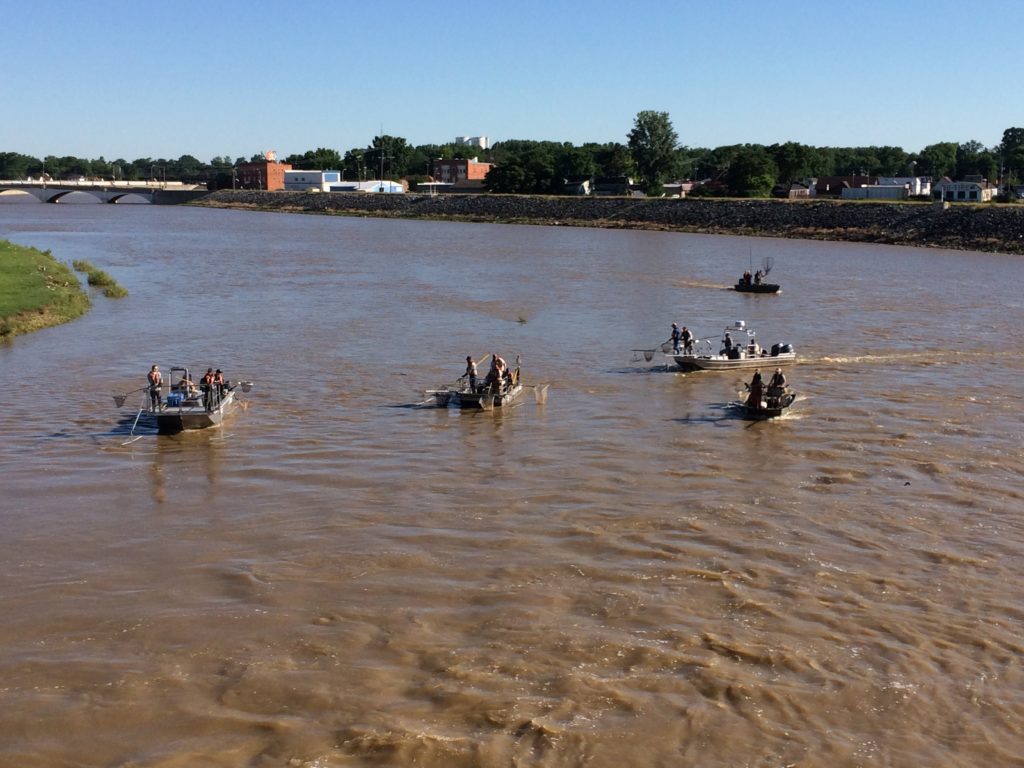Collaborative effort to sample for grass carp in Sandusky and Maumee Rivers

Fisheries biologists from multiple agencies, including the Ohio Department of Natural Resources, sampled the Maumee and Sandusky rivers for grass carp June 12-14. The increased knowledge of grass carp in western Lake Erie gained through this research allows natural resource agencies, working through the Great Lakes Fishery Commission, to collaboratively develop science-based management approaches and evaluate the effectiveness of different actions and strategies. Submitted photo.

COLUMBUS, Ohio – Fisheries biologists from multiple agencies recently conducted a project on the Sandusky and Maumee rivers to assess their ability to capture grass carp, according to the Ohio Department of Natural Resources (ODNR).
Crews from the ODNR Division of Wildlife worked with Michigan DNR; U.S. Fish and Wildlife Service; Department of Fisheries and Oceans Canada; Ontario Ministry of Natural Resources and Forestry; Minnesota DNR; Great Lakes Fishery Commission; The Nature Conservancy; U.S. Geological Survey; Quebec Ministry of Forest, Wildlife, and Parks; New York State Department of Environmental Conservation; Michigan State University; The Ohio State University; and the University of Toledo for three days of sampling looking for grass carp.
The crews sampled June 12-14 and included the coordinated use of multiple electrofishing vessels and nets to collect adult and juvenile carp in the Sandusky and Maumee rivers. Over the three days, 30 grass carp were collected, 27 from the Sandusky River and three from the Maumee River, using refined sampling techniques to collect grass carp for research and removal. Although present in the system, grass carp populations are considered to be low, and this week’s action reinforces this conclusion.
This week’s planned action is part of continuing efforts to remove invasive grass carp, assess grass carp capture techniques and increase information on grass carp populations in the Sandusky and Maumee rivers. This year’s planned response incorporated results from the 2017 coordinated unified response that tested grass carp collection strategies and the potential to control this species in the basin. This is one part of a structured and measured approach to better understand and address grass carp in Lake Erie.
The increased knowledge of grass carp in western Lake Erie gained through this research allows natural resource agencies, working through the Great Lakes Fishery Commission, to collaboratively develop science-based management approaches and evaluate the effectiveness of different actions and strategies.
The grass carp is an invasive species in the Great Lakes region and is one of four species commonly identified as Asian carp. All species of Asian carp do not have the same negative ecological effects. Grass carp present significantly different risks to the Lake Erie ecosystem compared to highly invasive bighead carp and silver carp.
An adult grass carp commonly weighs more than 20 pounds and can grow up to 48 inches long. The fish are primarily herbivorous, consuming large quantities of aquatic vegetation, and affect fish communities primarily through habitat modification.
Grass carp were actively stocked in private ponds in many states as early as the 1970s, and some have escaped. Grass carp have been detected in Lake Erie since the mid-1980s. Recent efforts to collect fish have resulted in low catch rates, indicating that fish are present in low densities. There is currently no evidence of negative ecological or economic impacts to the Lake Erie ecosystem attributed to grass carp.
ODNR ensures a balance between wise use and protection of our natural resources for the benefit of all. Visit the ODNR website at ohiodnr.gov.








